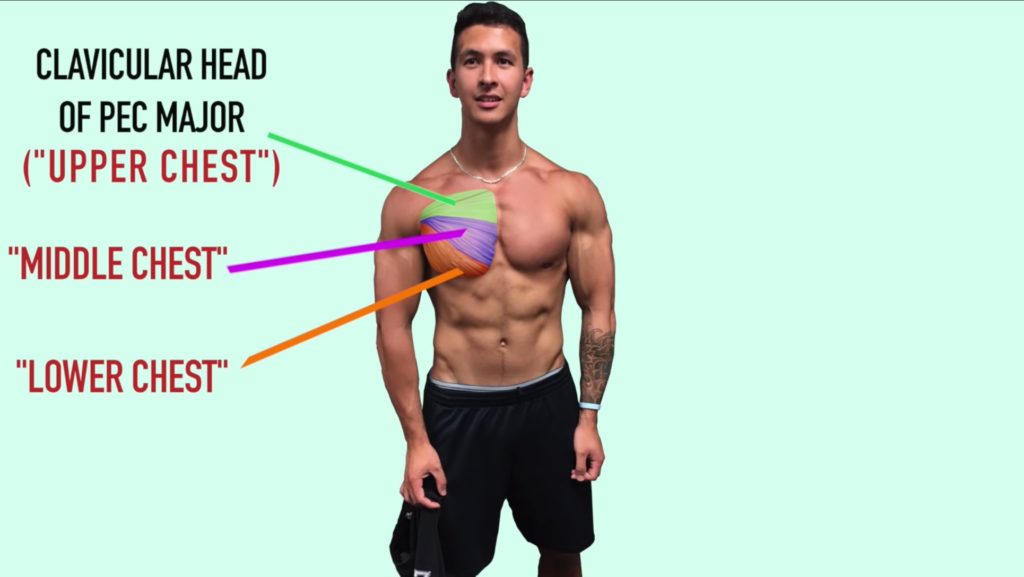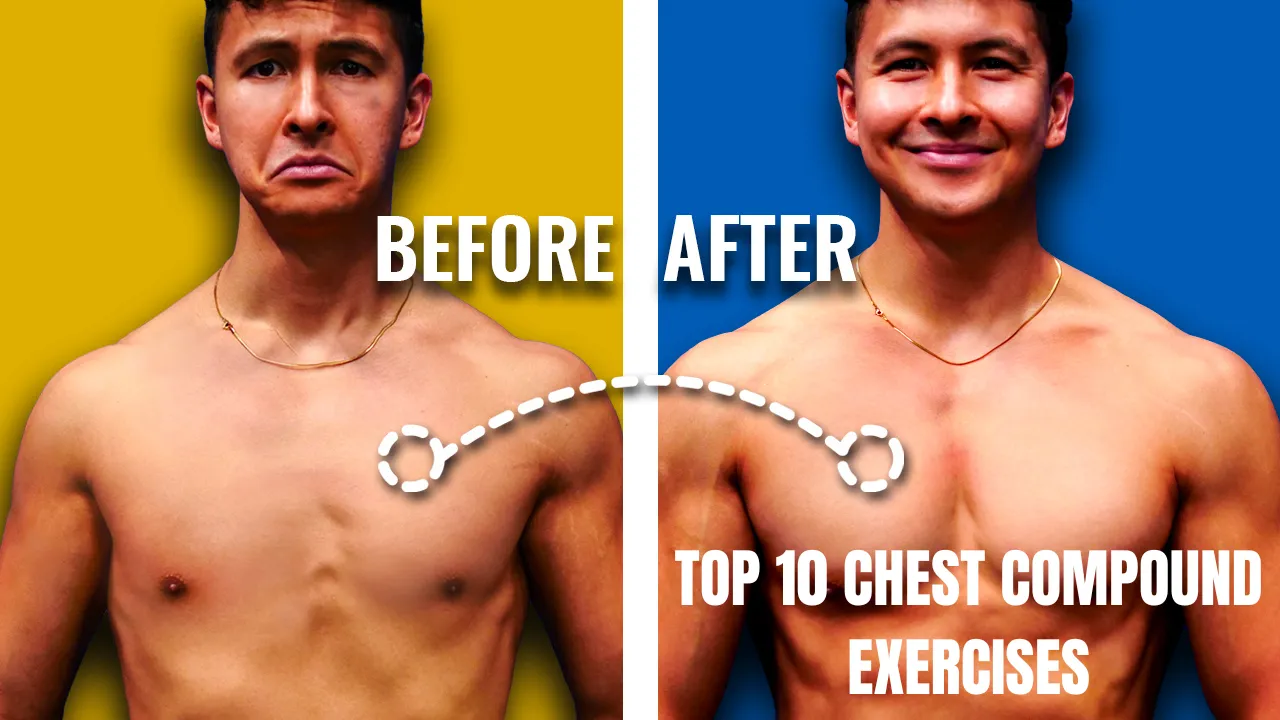
Best Chest Compound Exercises: Top 10 Exercises For A Stronger And Bigger Chest
Best Chest Compound Exercises
To-do: build chest muscles so big and thick they fill out your t-shirts.
How?
Option 1: pile as many plates onto the bar as possible and spam sets upon sets of barbell bench presses, then pray to the “chest gods”.
Option 2: consider the chest anatomy, then carefully select a variety of chest compound exercises that’ll challenge the muscles in different ways.
Which option is better?
OK, so my wording might have given it away, but yes, definitely go with option 2. And we see this clearly in a 2021 study published in the International Journal of Sports Medicine.
The researchers randomly assigned participants to 2 groups:
- No variety: Performed the same set of exercises in all 3 weekly training sessions (note: for the chest, they only did the bench press)
- Varied: Performed different exercises for each muscle group in each of their 3 weekly sessions (note: for the chest, they did the bench press, incline bench press, and decline bench press)
After 9 weeks, the varied group significantly increased muscle thickness at all 12 assessed sites, while the no-variety group didn’t.
Other studies comparing the hypertrophy effects of single exercise versus multiple exercises also found similar results — i.e., that the latter provides more well-rounded muscle growth — in the quads and triceps.
Right. So, use a variety of exercises. Got it. But which chest compound exercises should you go for, exactly? And why compound instead of isolation?
Benefits Of Chest Compound Exercises
Let’s tackle one question at a time, starting with why you should, in most cases, prioritize compound movements.
Now, as you may know:
- Compound exercises: Refers to movements that work multiple muscle groups across multiple joints. Examples of chest compound exercises include the push-up and barbell bench press.
- Isolation exercises: Refers to single-joint movements that tend to work only 1 muscle group. Examples of chest isolation exercises include the pec deck machine and seated cable fly.
When sets and reps are equated, compound and isolation exercises do equally well at eliciting hypertrophy in a specific target muscle group.
So, ultimately, it doesn’t matter which you pick … right? Not really.
See, compare the muscles targeted by the barbell bench press versus the pec deck machine:
- Barbell bench press: Chest, shoulders, and triceps
- Pec deck machine: Chest (yep, that’s it)
Bottom line?
Compared to their isolation counterparts, compound exercises give you more "hypertrophic bang" for your buck. Especially useful when you're in a time crunch and wish to compress all that training volume within a shorter session without compromising growth.
Another advantage some compound exercises have over isolation exercises: functionality. Imagine if you:
- Face-planted and had to push yourself off the ground: Same movement pattern as the push-up and barbell bench press.
- Had to scale a short wall (for whatever reason): Same movement pattern as the chest dip.
Now, think of a real-life scenario where you'd need to perform the chest fly movement. Um, no, you don’t need that much strength to hug someone or close your wardrobe doors.
That said, pay attention to my exact phrasing when it comes to compound exercises. In most cases, you should prioritize compound movements. That’s not the same as saying you should only do compound movements.
Isolation exercises also deserve a place on your workout routine because some of them can target (i.e., grow) a particular region of a muscle group better.
For example, as mentioned in this article I did on the best compound shoulder exercises, the lateral raises should ideally be your go-to exercise for growing your side delt so you build wider shoulders.
The same applies to the chest.
There are specific isolation movements that outperform compound chest exercises in terms of activation and, in most cases, resulting muscle growth. But before we talk about the specifics of that, let's first look at some of the best compound exercises for the chest.
Top 5 Best Compound Exercises For Chest
Anatomically, your chest (also known as the pectorals or “pecs”) is divided into 2 main regions:
- The clavicular head of the pec major: Also known as the “upper chest”
- The sternal head of the pec major: Divides into both the “middle chest” and the “lower chest” based on the way the fibers run
Although any chest exercise you do will activate both regions, specific exercises are better at emphasizing certain areas than others.
Compound Exercises For Upper Chest
Since the upper chest fibers run “upward”, they are best activated with compound chest exercises where the arms move upward.
And that's why we'll use the incline dumbbell press to target the upper chest.
15-Degree OR 30-Degree Incline Dumbbell Press
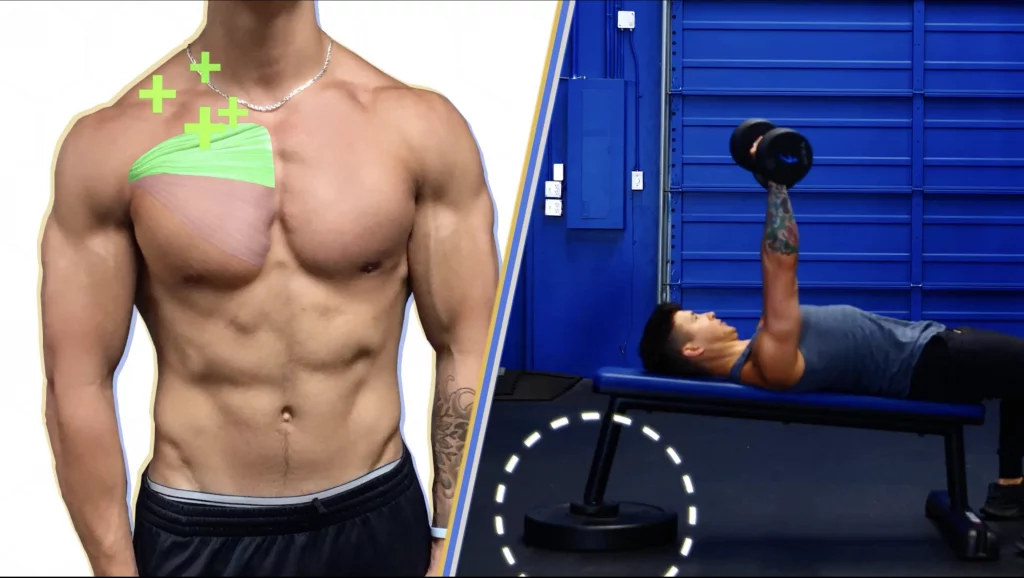
Equipment needed: Dumbbells and a bench
Why this exercise?
In an article where I used a ($12,000!) EMG machine to evaluate 17 chest exercises in an attempt to sift out the best chest exercises, I found that the 15-degree and 30-degree incline dumbbell presses ranked first and second when it came to upper chest activation numbers, respectively.
Because I know you’re wondering:
- 15 degrees: 1 notch up from the bottom position
- 30 degrees: 2 notches up from the bottom position
You could also place a weight plate under the bench.
FYI, research agrees that incline pressing movements help build the upper chest better than flat benching. Case in point? This 2020 study published in the International Journal of Exercise Science. The researchers randomly assigned the participants to 3 groups:
- Smith machine flat bench
- Smith machine incline bench
- Both exercises (i.e., flat and incline)
After 8 weeks, while all 3 groups experienced similar gains in mid- and lower-pec thickness, the group only performing incline press grew their upper chest significantly more than the other 2 groups.
Now, here’s a word of caution: it's not that the more inclined you are, the better.
In fact, exceeding 30 degrees will likely shift the tension from your upper chest to your front delts.
Oh, and of course, while I recommend using dumbbells on this exercise, you could definitely swap them out for the Smith machine instead (don’t worry; when sets and reps are equated, machines and free weights lead to similar muscle growth) for:
- A more fuss-free set-up (just drag a bench to the Smith machine and load up)
- More stability (this could help you better maintain the all-important mind-muscle connection to your upper chest muscles)
Compound Exercises For Mid Chest
The middle chest fibers run horizontally.
This means they’re best activated by chest exercises where the arms move directly horizontally.
Flat Dumbbell Press
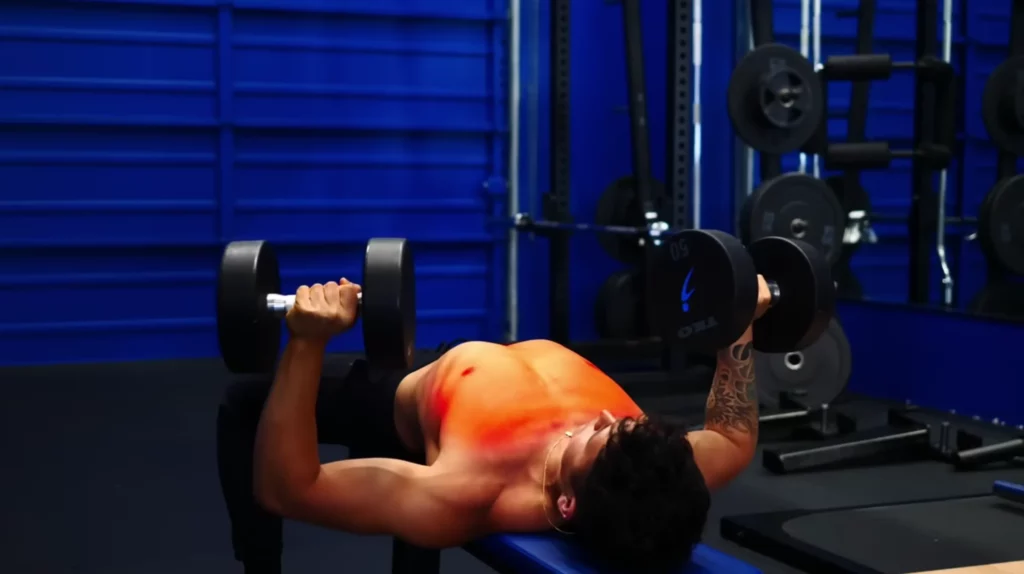
Equipment needed: Dumbbells and a bench
What’s special about this exercise?
Of course, the flat dumbbell press being great at activating the middle chest shouldn’t come as a surprise (horizontal arm path).
But to really maximize middle chest activation, you’ll need to pay attention to your dumbbell bench press form.
Here are a few quick pointers to get you started:
- Tuck your elbows to about 45 to 60 degrees away from the body
- Allow your grip to turn in slightly with your elbow
- Keep your forearm vertical over your elbow throughout each rep
- Avoid rounding your shoulders as you complete the rep (at the top position)
Slight Decline Dumbbell Press
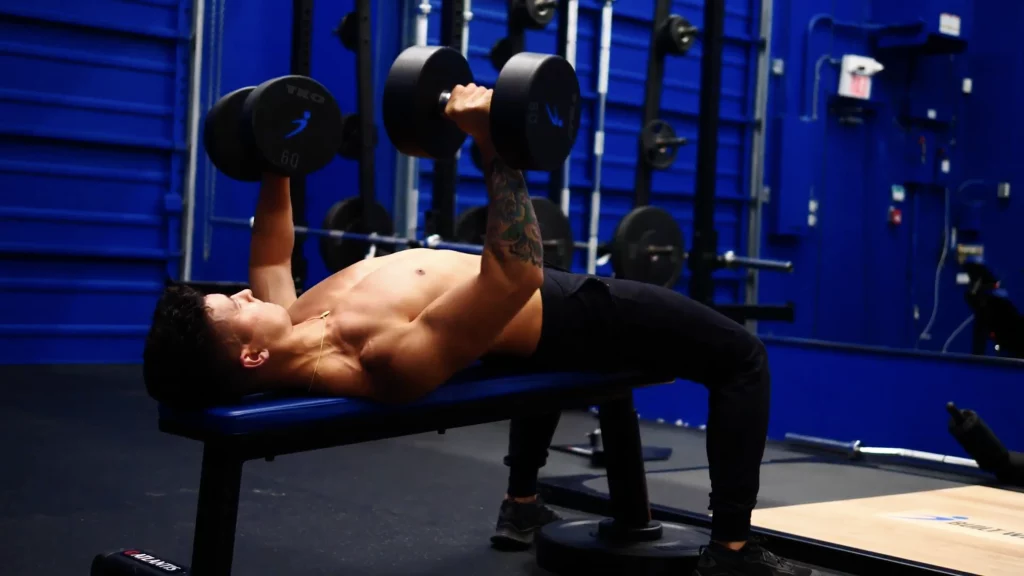
Equipment needed: Dumbbells, a weight plate, and a bench
Why this exercise?
Another compound chest exercise I’ve found to work the middle chest really well is the decline dumbbell press.
In fact, in my chest EMG article, it ended up outperforming the flat dumbbell press in terms of % MVC (maximum voluntary contraction) numbers for mid-chest activation. More specifically:
- Flat dumbbell press: 55.1%
- Decline dumbbell press: 58.8%
Bonus: while categorized as a “mid-chest” compound exercise, the slight decline dumbbell press is actually one of the best at activating the lower chest.
More specifically, according to my chest EMG article, second-best (falling behind only to seated cable fly, an isolation exercise).
With this exercise, we’ll skip the decline bench.
Instead, we’ll create the (slight) decline by simply placing a weight plate underneath the front of the bench.
Compound Exercises For Lower Chest
As for the lower chest?
Since the lower chest fibers run downwards, they are best activated by chest compound exercises that involve the arms moving downwards.
So, an obvious choice would be the decline dumbbell press, but it has already been covered, so our next choice would be the barbell bench press.
Oh, and psst: if you’re struggling with chest fat (or “moobs”), you might wish to consider prioritizing the following exercises, along with a calorie deficit. That's because most stubborn fat around the chest region tends to accumulate in the lower chest.
Barbell Bench Press
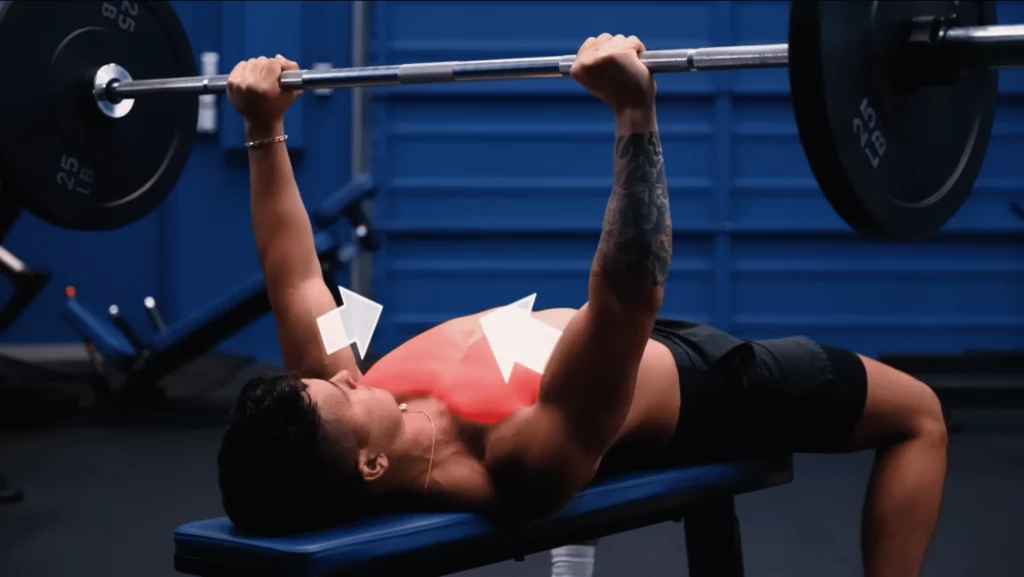
Equipment needed: Barbell, squat rack, and a bench
Why this exercise?
If you've been wondering when the barbell bench press would pop up, here it is.
In addition to activating the lower chest well, this G.O.A.T chest exercise also does great at activating the upper and middle chest regions; you can think of it as the ultimate “all-rounded” chest compound exercise.
That said, the barbell bench press can be tricky to get right.
So, here are a few crucial form tips that’ll help maximize chest activation while lowering your risk of shoulder and elbow injuries:
- Use the right grip width for your anatomy (not too wide, not too narrow)
- Create whole-body tension before unracking
- On the eccentric, bring the bar down and slightly forward toward your lower chest (instead of straight down)
- Keep your elbows tucked at about a 45- to 80-degree angle away from your body
- Drive the barbell back up in a slight arc
Interested in learning more? Here’s a step-by-step guide on how you can properly bench press for chest growth.
And, since we cannot overlook the importance of progressive overload for continued chest growth, you might also wish to check out this article on how to increase your bench press strength, too — so you can slap on those additional weight plates to the bar while maintaining good form.
Also, as with the incline dumbbell press, you could swap out the barbell for the Smith machine. Once again, this could give you a more stable set-up that may, in turn, promote better mind-muscle connection (and potentially more growth in the long-term!)
Chest Dip
Equipment needed: Weight-assisted chin-dip machine
Why this exercise?
Looking for one more chest compound exercise that targets the lower chest preferentially?
Well, luckily, there’s the chest dips. A word of caution, though: your front delts could easily take over the movement even with the proper form (that’s what happened to me!)
So, give it a go and see how it feels for you.
Chest Compound Exercises For Beginners
If you're new to the gym, I'd recommend machine-based exercises because they guide you through a fixed arm path — helping you build strength in your chest muscles while familiarizing you with the various movement patterns.
And don’t worry about “missing out” on gains.
A 2022 systematic review published in the Journal of Sports Medicine and Physical Fitness found that training with free weights or machines results in similar rates of muscle growth.
Here are my exercise recommendations for beginners:
- Upper chest: Incline machine press (great because there’s minimal set-up)
- Middle chest: Push-up (while this didn't do much for Alex and me in the chest EGM article, it ranked first in terms of mid-chest activation for Raza, a beginner lifter, but, as always, form is key — so make sure you get the push-up form right)
- Lower chest: Assisted chest dip (adjust the assistance according to your needs)
Compound Exercises For Chest Without Equipment
Think of compound exercises for the chest without equipment, and the number 1 exercise to pop into your mind will be bodyweight push-ups.
While these tend to preferentially activate the middle chest, you can shift the tension to:
- Upper chest: By performing decline close grip push-ups or wide reverse grip push-ups
- Lower chest: By performing dip push-ups
For specific form tips and how to progressively overload on those exercises, check out this article on the best at-home chest workout you could do.
How To Incorporate Chest Compound Exercises Into Your Routine
Here are a few ways you could put those exercises together for your chest workout in the gym.
Workout A
#1: Barbell Bench Press (3 sets, 6 to 8 reps)
#2: 15-Degree Dumbbell Press (3 sets, 8 to 12 reps)
#3: Slight Decline Dumbbell Press (3 sets, 8 to 12 reps)
Workout B
#1: Flat Dumbbell Press (3 sets, 8 to 12 reps)
#2: Incline Machine Press (3 sets, 6 to 8 reps)
#3: Chest Dip (3 sets, 8 to 12 reps)
Beginner-friendly workout
#1: Incline Machine Press (3 sets, 8 to 12 reps)
#2: Assisted Chest Dip (3 sets, 8 to 12 reps)
#3: Push-Up (3 sets, 10 to 15 reps)
Quick disclaimer: the routines listed above will likely give you more well-rounded chest development and growth than others in the gym who simply do sets upon sets of the barbell bench press.
But they alone are not enough to give you optimal chest development. Why?
Because you’re not leveraging the power of chest isolation exercises. See, here's what I didn't tell you: while the decline dumbbell press does well at activating the mid-chest, it's ranked second (58.8% MVC) — behind seated cable fly (69.2% MVC), an isolation exercise.
In fact, you'd see the same thing happen in lower chest activation. The decline dumbbell press comes in second (94.6% MVC) behind the seated cable fly (101.2% MVC).
Bottom line? You should include a good mix of compound and isolation exercises in your training routine for optimal hypertrophy. Not just for your chest muscles but for all muscles.
And if you’re looking for a science-based training program that’ll show you exactly how to train (e.g., what exercise to do, what order to do it in, and how many sets and reps) for the quickest body transformation, just take my free analysis quiz below:
Click the button below to take my analysis quiz to discover the best program for you:
↓






